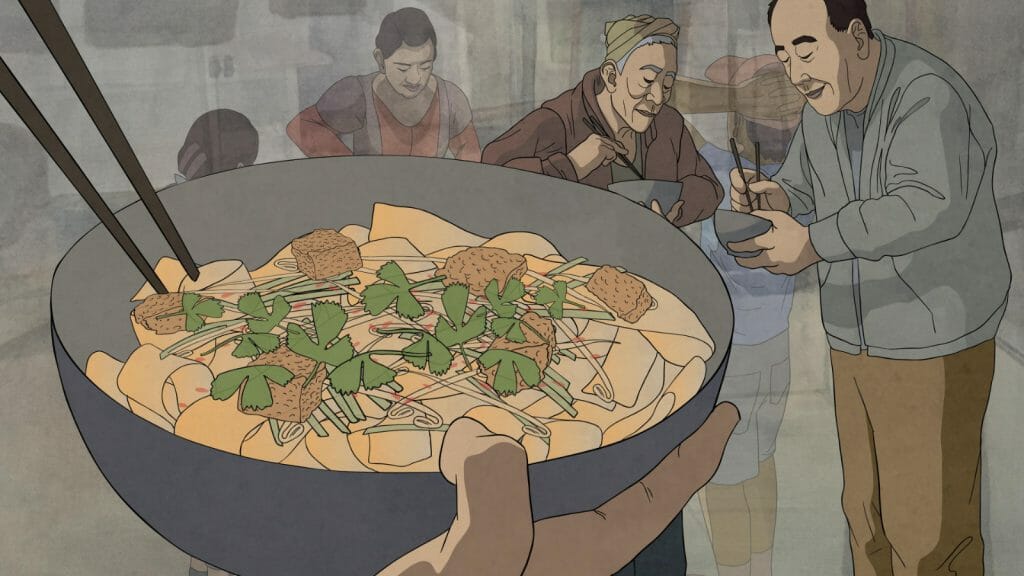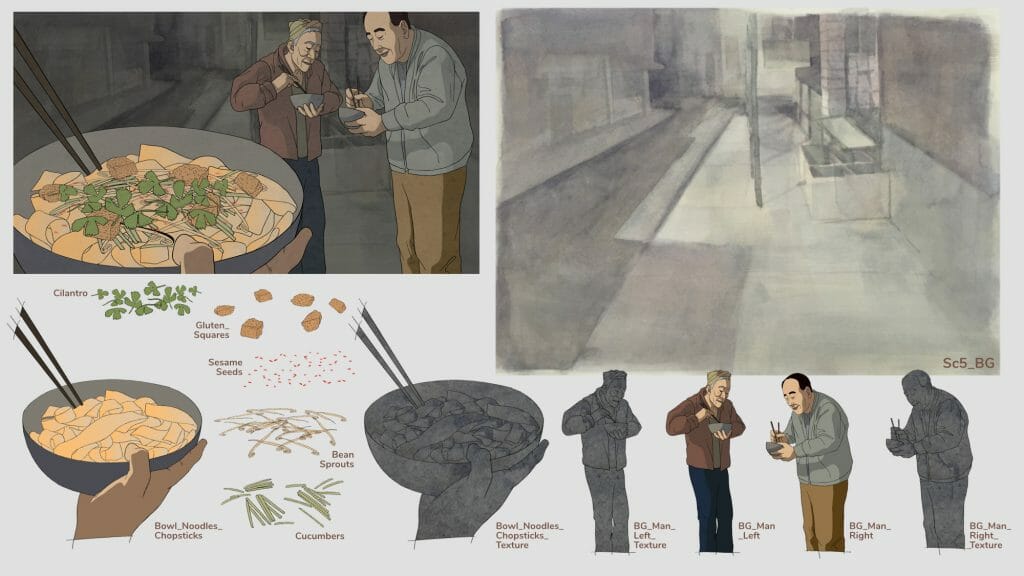Toon Boom Moving Art on Both Line and Color Layer
To encourage animators to try out new tools and techniques following the release of Harmony 21, Toon Boom Animation assembled a demo pack titled "The Ingredients of Animation," which features work from half dozen artists participating in the company'southward Administrator Programme. Each artist hired for the project contributed scenes, made using a variety of cutout and paperless techniques — and were inspired by recipes they accept a personal connection to.
Nutrient and family are oftentimes inextricably baked together as concepts, at least for Mollie Ong. During lockdown, the L.A.-based animator and daughter of Singaporean immigrants got a sense of taste for her heritage by learning to make liang pi, an ancient noodle dish whose proper noun translates to "common cold peel." She and then brought this connectedness with heritage and history to life using Harmony 21.
Though Ong is a Toon Boom Ambassador and recent CalArts graduate, she only began using Harmony recently. One would never know, given how seasoned her 10-second short felt. Ong's Instagram illustrates the artistic gustatory modality she has for hand-drawn sketches and watercolor paintings, both of which she was able to integrate effortlessly into her piece using Harmony 21'southward layering, cartoon, and coloring tools.
The results, much similar liang pi, are best served common cold. Cooked upward over vi weeks, Ong's brusque feels professional person and polished, playfully using the magic ingredients of frame-by-frame paperless hand-drawn animation and an expansive color palette to create a truly savory piece that tells the story of this timeless dish. Below, Ong tells us about her artistic journey, how she prepared her brusk in only six weeks, and which Harmony 21 tools helped along the way.
Drawing Mash: How did you lot get into animation?
Mollie Ong: I've been drawing since I was a kid, though nobody in my family was really into art. When my parents would ask me what I wanted to be, I answered an creative person — and so they were like, "But what do you lot really want to be?" I didn't see art as a career option until high schoolhouse.
James Jean'south artwork made me desire to become into art professionally. I was really inspired by his illustrations. I started exploring creative jobs that could back up me and animation was ane of them, then I looked into it as a senior. I did two years of animation at customs college before transferring to CalArts. And I accept been working in animation since graduating.
What are yous working on at the moment?
I've been doing a lot of work with Watcher Amusement. Information technology's a YouTube aqueduct by Ryan Bergara and Shane Madej from BuzzFeed. I've been helping out mainly with the Are You Scared serial and they're starting to bring me onto other minisodes.
And you've been working on the Harmony 21 demo! How long take you lot been using Toon Boom Harmony for?
I was more familiar with Storyboard Pro going through school at CalArts; I didn't really get a chance to endeavour Toon Nail Harmony until I go an administrator earlier this year. Information technology's been actually easy to learn, and I was able to pick it up for this piece. I've been playing effectually with it and trying to create a new demo reel with information technology.

Information technology'south amazing that yous produced such a beautiful and technical piece, having just picked upwardly Harmony!
Aye, I was freaking out, but then when I got hands-on with information technology everything made sense. The hotkeys and all the shortcuts fabricated it a lot faster.
What made yous want to learn Toon Boom Harmony?
I wanted to learn Harmony mainly because it is vector-based. I saw a lot of work coming out that looked make clean and that was something I ever missed with other programs. The cleanup was also really simple.
What was the inspiration for the slice y'all created in Harmony 21?
Since the pandemic began, I took the take a chance to acquire more about cooking traditional Chinese nutrient. Growing up, my parents gave usa more than of an American household then we would fit in more. I've been researching Chinese cooking and the history backside it, so I thought this was the best chance to play with those ideas.
I chose a dish called common cold noodles, or liang pi — an ancient dish created past one of the first dynasties. For this piece, I tried to incorporate imagery from older times so bring it into the modernistic era. We start with the ladies kneading the dough in a more rustic location so we end with it being sold in the street from a food stall in People's republic of china, which is kind of how you see it today.

Did you learn how to make liang pi yourself during lockdown?
Yeah, through a lot of trial and mistake. [Laughs]
When you take the time during lockdown, why not?
Yep, and it was hard to observe what parts of the process to include in the story because I only had ten seconds. The first scene was boiling the spices, and so we go into kneading the dough and steaming — and so eating, of form.
The most important role! And so how long did it have y'all to produce that whole ten-second curt?
Information technology took a good month and two weeks, working 8-to-12-hour days.
Your piece of work has a cute watercolor and sketch quality to it. Could you tell united states of america about how you used Harmony 21 to create that look?
It was actually a lot simpler than I thought it would exist. Information technology was just a matter of bringing in a scan texture and adding it onto the colur swatch option before layering the different colors on the same objects. Harmony also immune me to manipulate the texture so that it moved along with the characters. And then I would just have to pick through some of the frames that were non in the correct position and reposition them.
Information technology looks similar you besides played with the opacity tools, color palettes, and the paint tools. How did those factor into creating this watercolor outcome?
Harmony 21 allowed me to color sure parts of the image, texture that, and so create an overlapping shape over that existing texture with a different color at a different opacity. It created this watercolor effect where y'all accept these overlapping strokes. It is a lot of creating individual shapes that represent brushstrokes and then combining them to create a whole image.
Some other of the other standout parts of your brusk was that scene transition with the basin of noodles. How did yous do that?
It was just a matter of layering the timeline so that the bowl of noodles overlapped on the previous scene, and so at one bespeak covered the width of the scene. That's where I was able to cut out the previous scene and get-go the side by side ane. Only a uncomplicated graphic swipe, actually.
Basically, just another use of Harmony 21'south layering tool?
Yeah, only in the overall timeline. With that scene, considering I had to animate the bowl of noodles too as it swiped beyond, Harmony came in handy: you could re-create and paste and reuse the previous frame without losing the line quality, considering it is vector-based. I was able to practise that scene transition in ii days, whereas before it would have taken me a calendar week.
When you used the basin to transition into the side by side scene and the noodles and cilantro are moving around too, was that also using layering?
First, I had to do the actual noodle animation and that was frame-by-frame tracking. For the other ingredients, I had to rails them on top of the noodles and how they move. Again, frame by frame, moving each — selecting and moving or erasing and redrawing, depending on how it moved with the noodles.
You're hand-drawing them all the way along?
Yes. [Laughs]
That'due south amazing! As an artist relatively new to the program, are you enjoying Harmony's mitt-cartoon features?
Yeah, definitely. I prefer to hand-draw because information technology just gives a dissimilar feeling, rather than only puppet movements. It allowed me to do the noodles with that fluid motility.

Were at that place whatever other Harmony 21 features that really stood out?
The coloring tools. The fact that you could utilize the pen tool to make an invisible line so that you can shade quickly. Transferring the linework to the under layers allowed me to practise really sketchy animation and clean upwards on another layer, and so transfer that aforementioned information to the color layers.
Information technology was really amazing what yous did in half-dozen weeks, peculiarly since you lot were learning Harmony as you went.
Yep, the program made it a lot easier to do it fast.
What other projects practise you have coming up?
So far, information technology'due south just freelancing for smaller companies. I'm also trying to pursue oil painting on the side. Somehow, I desire to create a demo reel that merges my beloved for painting and blitheness past animative this painting look. I'm just waiting for the correct amount of time to endeavor to develop that.
And do you think yous'll do that in Harmony?
Definitely. I but need more fourth dimension to play around with the tools!
Want a gustation of the newest features in Harmony 21? Detect the new features hither and download a 21-twenty-four hours trial. Curious about the other "Ingredients of Animation"? You can detect more articles nigh the participating artists hither.
Source: https://www.cartoonbrew.com/sponsored-by-toon-boom/how-mollie-ong-animated-her-first-toon-boom-harmony-short-in-6-weeks-209505.html
0 Response to "Toon Boom Moving Art on Both Line and Color Layer"
ارسال یک نظر